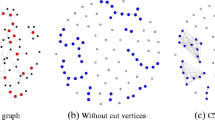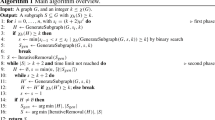Abstract
In this paper, we propose a polynomial-time algorithm for solving the Component-Cardinality-Constrained Critical Node Problem (3C-CNP) on bipartite permutation graphs. This problem, which is a variant of the well-known Critical Node Detection problem, consists in finding the minimal subset of nodes within a graph, the deletion of which results in a set of connected components of at most K nodes each one, where K is a given integer. The proposed algorithm is a dynamic programming scheme of time complexity \(O(nK^2)\), where n is the number of nodes. To provide evidences of algorithm’s efficiency, different experiments have been performed on randomly generated graphs.




Similar content being viewed by others
Notes
Only the execution time of the equations is computed, without the time of loading data from files.
References
Arulselvan, A., Commander, C.W., Shylo, O., Pardalos, P.M.: Cardinality-constrained critical node detection problem. In: Gülpınar, N., Harrison, P., Rüstem, B. (eds.) Performance Models and Risk Management in Communications Systems, pp. 79–91. Springer, New York (2011)
Dinh, T.N., Xuan, Y., Thai, M.T., Park, E., Znati, T.: On approximation of new optimization methods for assessing network vulnerability. In: INFOCOM, 2010 Proceedings IEEE, pp. 1–9. IEEE (2010)
Kempe, D., Kleinberg, J., Tardos, É.: Influential nodes in a diffusion model for social networks. In: Caires, L., Italiano, G.F., Monteiro, L., Palamidessi, C., Yung, M. (eds.) Automata, Languages and Programming. ICALP 2005. Lecture Notes in Computer Science, pp 1127–1138. Springer, Berlin (2005)
Lalou, M., Tahraoui, M.A., Kheddouci, H.: The critical node detection problem in networks: a survey. Comput. Sci. Rev. 28, 92–117 (2018)
Shen, S., Smith, J.C.: Polynomial-time algorithms for solving a class of critical node problems on trees and series-parallel graphs. Networks 60(2), 103–119 (2012)
Yannakakis, M.: Node-and edge-deletion NP-complete problems. In: Proceedings of the Tenth Annual ACM Symposium on Theory of Computing, pp. 253–264. ACM (1978)
Addis, B., Di Summa, M., Grosso, A.: Identifying critical nodes in undirected graphs: complexity results and polynomial algorithms for the case of bounded treewidth. Discrete Appl. Math. 161(16), 2349–2360 (2013)
Arulselvan, A., Commander, C.W., Elefteriadou, L., Pardalos, P.M.: Detecting critical nodes in sparse graphs. Comput. Oper. Res. 36(7), 2193–2200 (2009)
Di Summa, M., Grosso, A., Locatelli, M.: Complexity of the critical node problem over trees. Comput. Oper. Res. 38(12), 1766–1774 (2011)
Dinh, T.N., Thai, M.T.: Assessing attack vulnerability in networks with uncertainty. In: IEEE International Conference on Computer Communications (INFOCOM). IEEE (2015)
Aringhieri, R., Grosso, A., Hosteins, P., Scatamacchia, R.: A preliminary analysis of the distance based critical node problem. Electron. Notes Discrete Math. 55, 25–28 (2016)
Aringhieri, R., Grosso, A., Hosteins, P., Scatamacchia, R.: Polynomial and pseudo-polynomial time algorithms for different classes of the distance critical node problem. Discrete Appl. Math. (2018). https://doi.org/10.1016/j.dam.2017.12.035
Veremyev, A., Prokopyev, O.A., Pasiliao, E.L.: Critical nodes for distance-based connectivity and related problems in graphs. Networks 66(3), 170–195 (2015)
Lalou, M., Tahraoui, M.A., Kheddouci, H.: Component-cardinality-constrained critical node problem in graphs. Discrete Appl. Math. 210, 150–163 (2016)
Berger, A., Grigoriev, A., Zwaan, R.: Complexity and approximability of the k-way vertex cut. Networks 63(2), 170–178 (2014)
Shen, S., Smith, J.C., Goli, R.: Exact interdiction models and algorithms for disconnecting networks via node deletions. Discrete Optim. 9(3), 172–188 (2012)
Nguyen, D.T., Shen, Y., Thai, M.T.: Detecting critical nodes in interdependent power networks for vulnerability assessment. IEEE Trans. Smart Grid 4(1), 151–159 (2013)
Aringhieri, R., Grosso, A., Hosteins, P., Scatamacchia, R.: A general evolutionary framework for different classes of critical node problems. Eng. Appl. Artif. Intell. 55, 128–145 (2016)
Dinh, T.N., Thai, M.T.: Precise structural vulnerability assessment via mathematical programming. In: Military Communications Conference, 2011-MILCOM 2011, pp. 1351–1356. IEEE (2011)
Dinh, T.N., Thai, M.T.: Network under joint node and link attacks: vulnerability assessment methods and analysis. IEEE/ACM Trans. Netw. 23(3), 1001–1011 (2015)
Di Summa, M., Grosso, A., Locatelli, M.: Branch and cut algorithms for detecting critical nodes in undirected graphs. Comput. Optim. Appl. 53(3), 649–680 (2012)
Oosten, M., Rutten, J.H., Spieksma, F.C.: Disconnecting graphs by removing vertices: a polyhedral approach. Stat. Neerl. 61(1), 35–60 (2007)
Arulselvan, A., Commander, C.W., Pardalos, P.M., Shylo., O.: Managing network risk via critical node identification. In: Gulpinar, N., Rustem, B. (eds.) Risk Management in Telecommunication Networks. Springer, Berlin (2007)
Ventresca, M., Aleman, D.: A randomized algorithm with local search for containment of pandemic disease spread. Comput. Oper. Res. 48, 11–19 (2014)
Ventresca, M.: Global search algorithms using a combinatorial unranking-based problem representation for the critical node detection problem. Comput. Oper. Res. 39(11), 2763–2775 (2012)
Hermelin, D., Kaspi, M., Komusiewicz, C., Navon, B.: Parameterized complexity of critical node cuts. Theor. Comput. Sci. 651, 62–75 (2016)
Veremyev, A., Prokopyev, O.A., Pasiliao, E.L.: An integer programming framework for critical elements detection in graphs. J. Combin. Optim. 28(1), 233–273 (2014)
Brandes, U.: A faster algorithm for betweenness centrality. J. Math. Sociol. 25(2), 163–177 (2001)
Spinrad, J., Brandstädt, A., Stewart, L.: Bipartite permutation graphs. Discrete Appl. Math. 18(3), 279–292 (1987)
Uehara, R., Valiente, G.: Linear structure of bipartite permutation graphs and the longest path problem. Inf. Process. Lett. 2(103), 71–77 (2007)
Tomaino, V., Arulselvan, A., Veltri, P., Pardalos, P.M.: Studying connectivity properties in human protein-protein interaction network in cancer pathway. In: Pardalos, P., Xanthopoulos, P., Zervakis, M. (eds.) Data Mining for Biomarker Discovery, pp. 187–197. Springer, Boston (2012)
Lalou, M., Kheddouci, H.: Least squares method for diffusion source localization in complex networks. In: Cherifi, H., Gaito, S., Quattrociocchi, W., Sala, A. (eds.) Complex Networks & Their Applications V, pp. 473–485. Springer, Cham (2016)
Lalou, M., Kheddouci, H., Hariri, S.: Identifying the cyber attack origin with partial observation: a linear regression based approach. In: 2017 IEEE 2nd International Workshops on Foundations and Applications of Self* Systems (FAS* W), pp. 329–333. IEEE (2017)
Michael, R.G., David, S.J.: Computers and Intractability: A Guide to the Theory of NP-Completeness. WH Freeman & Co., San Francisco (1979)
Balas, E., de Souza, C.C.: The vertex separator problem: a polyhedral investigation. Math. Program. 103(3), 583–608 (2005)
Veremyev, A., Boginski, V., Pasiliao, E.L.: Exact identification of critical nodes in sparse networks via new compact formulations. Optim. Lett. 8(4), 1245–1259 (2014)
Pullan, W.: Heuristic identification of critical nodes in sparse real-world graphs. J. Heuristics 21(5), 577–598 (2015)
Saitoh, T., Otachi, Y., Yamanaka, K., Uehara, R.: Random generation and enumeration of bipartite permutation graphs. J. Discrete Algorithms 10, 84–97 (2012)
Author information
Authors and Affiliations
Corresponding author
Additional information
Publisher's Note
Springer Nature remains neutral with regard to jurisdictional claims in published maps and institutional affiliations.
Rights and permissions
About this article
Cite this article
Lalou, M., Kheddouci, H. A polynomial-time algorithm for finding critical nodes in bipartite permutation graphs. Optim Lett 13, 1345–1364 (2019). https://doi.org/10.1007/s11590-018-1371-6
Received:
Accepted:
Published:
Issue Date:
DOI: https://doi.org/10.1007/s11590-018-1371-6




